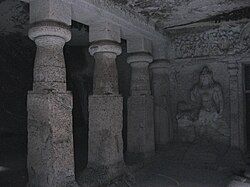Jogeshwari Caves
This article needs additional citations for verification. (December 2017) |
| Jogeshwari Caves | |
|---|---|
 Jogeshwari caves interior | |
| Location | Jogeshwari (E), Mumbai |
| Coordinates | 19°08′21″N 72°51′24″E / 19.1391°N 72.8568°E |
| Elevation | 15 m (49 ft) |
| Entrances | 3 |
| Difficulty | easy |
The Jogeshwari Caves are some of the earliest Hinduism cave temple sculptures located in the Mumbai suburb of Jogeshwari, India. The caves date back to the sixth century, Chalukya dynasty.[1] They were found during the excavation of Ajanta and Elephanta.[2] These caves belong to the Hindu deity Jogeshwari. According to historian and scholar Walter Spink, Jogeshwari is the earliest major cave temple in India and (in terms of total length) "the largest".[3]

The caves are located off the Western Express Highway, and are surrounded by encroachments. The caves are accessed through a long flight of stairs into the main hall of this cavernous space. It has many pillars and a Lingam at the end. Idols of Dattatreya, Hanuman, and Ganesh line the walls. There are also relics of two doorkeepers. The cave also has a murti and footprints of the goddess Jogeshwari (Yogeshwari), after whom the area is named. The goddess is considered a Kuladevi by some Marathi people and also worshipped by some migrant groups from Gujarat. These caves are the earliest Pashupata Caves in Mumbai.[4] The caves contain six sculptural panels depicting different episodes from Shaivism, including the marriage of Shiva and Parvati, Andhakasura Vad, Shiva accepting Ravana as his disciple, Shiva and Parvati playing dice, Nataraja and Lakulisha Shiva.[5] The cave also includes sculptures and pillars of Mahayana Buddhist architecture.[2]
References
[edit]- ^ Dalal, Roshen (18 April 2014). The Religions of India: A Concise Guide to Nine Major Faiths. Penguin UK. ISBN 978-81-8475-396-7.
- ^ a b Chowdhury, Arka Roy. "Jogeshwari Caves – all you need to know about the first and largest Hindu temple caves in India". The Times of India. Retrieved 15 January 2024.
- ^ Walter M. Spink; University of Michigan. Center for South and Southeast Asian Studies (1967). Ajanta to Ellora. Marg Publications. Retrieved 19 April 2012.
- ^ Pandit, Dr. Suraj (December 2013). Stories in Stone - Historic Caves of Mumbai by Dr. Suraj Pandit with Arun Narayanan (1st ed.). Instucen Trust. p. 80.
- ^ Pandit, Dr. Suraj (December 2013). Stories in Stone - Historic Caves of Mumbai by Dr. Suraj Pandit with Arun Narayanan (1st ed.). Instucen Trust. p. 80.
External links
[edit]
- Caves around Mumbai
- Hindu temples in Mumbai
- Hindu cave temples in Maharashtra
- Rock-cut architecture of India
- Former populated places in India
- Caves containing pictograms in India
- 6th-century establishments in India
- Gupta art
- Legendary footprints
- Monuments of National Importance in Maharashtra
- Indian religious building and structure stubs
